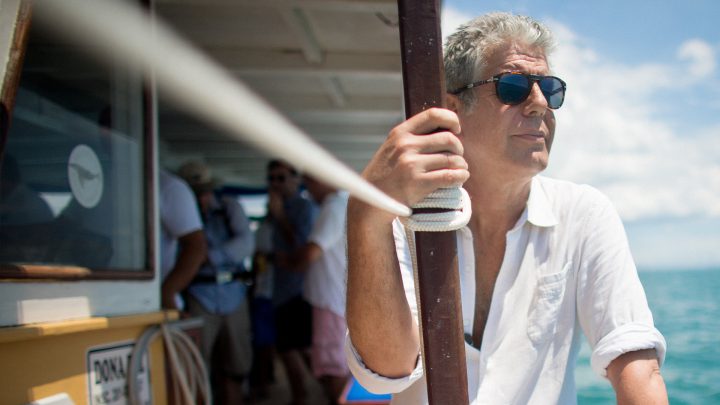
When chef Anthony Bourdain visited Brooklyn for the final episode of his travel and food series No Reservations, it was his guest star Michael K. Williams (a character actor best-known for playing Omar Little on The Wire) who got the hero’s welcome. Walking around his home neighborhood, Williams stops to greet friends and relatives on every corner. He may be the host of the show, but Bourdain is content to step back and enjoy Williams’s moment. Throughout the various TV programs he starred in, it was never Bourdain’s style to be the center of attention at the many places he visited — instead, he hoped the center would occupy him. It’s then perhaps antithetical to Bourdain’s ethos that he should now be the focus of a documentary exploring his life and career: Morgan Neville’s Roadrunner, which opens in theaters this week. One could actually learn more about the man through his work.
Experiencing food in its cultural and political contexts was primarily what intrigued Bourdain and made his shows so compelling, along with his exceptional humility. From A Cook’s Tour (2002-2003) through Parts Unknown (2013-2018), the grizzled rock star chef travelled the world to understand food in new ways, and more importantly, to meet the people who make and eat it. His charm was undeniable; Nigella Lawson described his conversational style as ranging from “erudite to brilliantly slangy.” This and his slouchy leather blazer and single hoop earring were the keys to his effortless “cool guy” aesthetic in his early days on television. Though his travel antics were far from realistically attainable for most people, he never seemed like someone out of reach. Everybody wanted to grab a beer with Anthony Bourdain.
Though he led four different shows (A Cook’s Tour, No Reservations, The Layover, and Parts Unknown) across various networks over the years, Bourdain’s work feels very much as part of a single continuity. They share highly similar aesthetics, starting with the punchy opening title sequences set to guitar-heavy music which splatter images of the chef eating and exploring in rapid succession. All focus on sound as fundamental to the dining experience, paying attention to the chatter of patrons, the screech of cars on streets, the vibrancy of city centers. And of course, there is always Bourdain’s voiceover, marked by a distinctly macho tone and full of poignant self-reflection, navigating both the bravado of a rowdy past (as documented in his bestselling 2000 book Kitchen Confidential, which transformed him from a mere chef to a media personality) and his personal sensitivities. That delicate balance of noise and poetry made each episode feel as though it contained Bourdain’s very essence.
Growing up in the UK, my understanding of food and travel shows was shaped by a lineup of white male chefs like Keith Floyd (perhaps the first to popularize the format), Rick Stein, and more recently the so-called “Hairy Bikers.” They would travel to places like Mexico, Thailand, and Vietnam to gawk at the locals and create bastardized, anglicized versions of the local recipes for the audience. Meanwhile, female chefs like Mary Berry, Julia Child, and Nadiya Hussain were confined to the home to demonstrate recipes. An important factor of Bourdain’s approach was that, despite being a chef, he was rarely seen cooking. The mantra of his shows was to move, to get up and out of the house, to see the world and its many food cultures, not to poorly mimic them at home. This, of course, was a huge privilege of Bourdain’s, and his travels were not without their complexities, particularly when considered as part of an arguably colonialist tradition. Tunde Wey wrote about Bourdain’s “lavishly exoticized treatment” of Lagos in the San Francisco Chronicle. And as food writer Alicia Kennedy notes, Bourdain’s “cis straight white maleness is not to be overlooked. Only [Samin] Nosrat has been able to do something similar — and she was always in the kitchen, too, showing the viewer a cooking lesson. That was both the point and is clearly gendered.”
Nosrat’s Netflix series Salt, Fat, Acid, Heat, along with the recent Stanley Tucci venture Searching for Italy and the Stephen-Satterfield-hosted High on the Hog, are examples of the way Bourdain’s approach has influenced this genre. Though the respective hosts’ personas differ — Nosrat is more instructional, Tucci more glamorous, Satterfield more pensive — they share Bourdain’s ethos of seeking out both established institutions and street-level vendors, community centers and Michelin-starred restaurants alike. They revel in the experience of food and its history and contexts, going beyond surface-level education about other countries.
As food and travel television continues to evolve, there is perhaps some comfort for fans of Bourdain, who died by suicide in 2018. Even in imitation, however good or bad, his presence continues to be felt. His shows created a crucial space for conversation, for listening to others share their experiences in the countries and neighborhoods they have long known, and to savor good company around tables piled high with good food.
0 Commentaires